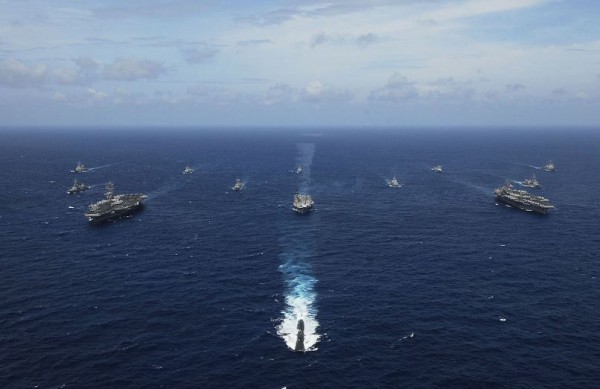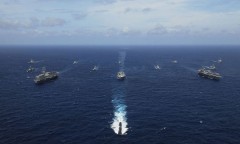By Arthur Dominic J. Villasanta , | May 31, 2017

Warships of the United States, India, Japan, Australia and Singapore in the Bay of Bengal during Exercise Malabar.
For the second time since 2007, India has turned down Australia's request to participate in Asia's largest multinational naval wargames -- Exercise Malabar -- out of fear of distressing China.
India's unexpected kowtow to China was even more marked since Australia wanted to participate merely as an official observer and not as a major participant deploying warships to the exercise, which will be held in July.
Like Us on Facebook
The Australian government confirmed the non-participation of the Royal Australian Navy in Exercise Malabar.
"Australia has not been invited to join Exercise Malabar 2017," said a spokesperson for the Ministry of Defense.
"Australia has regularly discussed the matter of the Royal Australian Navy's involvement in Exercise Malabar with India since 2015."
Australian Defense Minister Marise Payne last April said Australia wanted to join Exercise Malabar.
"Australia is very interested in a quadrilateral engagement with India, Japan and the United States," said Payne. "What form that may take is a matter of discussion between our various countries."
Exercise Malabar-2017 will take place in the Bay of Bengal. For the third straight year, warships of the Japan Maritime Self-Defense Force (JMSDF) will join those of the Indian Navy and the U.S. Navy in the annual Exercise Malabar naval drill, which today is aimed at curtailing China's expansion into the Indian Ocean and the Western Pacific.
First held in 1992 with the joint participation of the Indian Navy and the U.S. Navy, Exercise Malabar includes diverse naval warfare activities, ranging from fighter combat operations from aircraft carriers through Maritime Interdiction Operations Exercises.
Exercise Malabar-2017 is designed to enhance dynamic cooperation between Indian Navy, JMSDF and the U.S. Navy in the Indo-Asia-Pacific. It allows for practical training, while exchanging skills and cultures, and helps to increase the understanding of joint multinational naval operations.
These were the same aims in Exercise Malabar 2016.
Among the U.S. Navy warships at Exercise Malabar-2016 were the Nimitz-class aircraft carrier USS John C. Stennis (CVN-74); USS Mobile Bay (CG-53), a Ticonderoga-class guided missile cruiser and USS Stockdale (DDG-106) and USS Chung Hoon (DDG-93), both Arleigh Burke-class guided missile destroyers.
The Japan Maritime Self-Defense Force (JMSDF) warships at Exercise Malabar-2016 were led by the JS Hyūga (DDH-181), lead ship of the Hyūga-class of helicopter destroyers.
The Indian Navy was represented at Exercise Malabar-2016 by INS Sahyadri (F49), a Shivalik-class stealth multi-role frigate; INS Satpura (F48), a Shivalik-class stealth multi-role frigate; INS Kirch (P62), a Kora-class guided missile corvette and INS Shakti (A57), a Deepak-class fleet tanker.
-
Use of Coronavirus Pandemic Drones Raises Privacy Concerns: Drones Spread Fear, Local Officials Say

-
Coronavirus Hampers The Delivery Of Lockheed Martin F-35 Stealth Fighters For 2020

-
Instagram Speeds Up Plans to Add Account Memorialization Feature Due to COVID-19 Deaths

-
NASA: Perseverance Plans to Bring 'Mars Rock' to Earth in 2031

-
600 Dead And 3,000 In The Hospital as Iranians Believed Drinking High-Concentrations of Alcohol Can Cure The Coronavirus

-
600 Dead And 3,000 In The Hospital as Iranians Believed Drinking High-Concentrations of Alcohol Can Cure The Coronavirus

-
COVID-19: Doctors, Nurses Use Virtual Reality to Learn New Skills in Treating Coronavirus Patients








